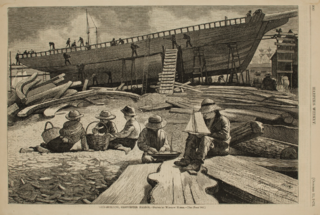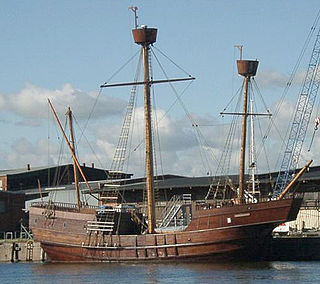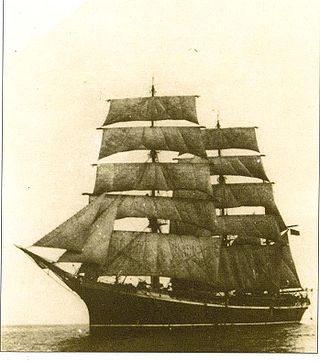| Length | Beam | Name | Service | Fate | Notes |
|---|
69 m
(226 ft) | 15.7 m
(51 ft 10 in) |  HMS Victory HMS Victory | 1765– | still in commission, but not for active service; effectively museum ship | A 104-gun ship of the line of the Royal Navy. Oldest naval ship still in commission and the only remaining ship of the line. Currently in dry dock at Portsmouth as a museum ship. It is the flagship of the First Sea Lord. |
69 m
(226 ft)
(estimated) | 11.7 m
(38 ft) |  Vasa Vasa | 1628 | sunk, later museum ship | A warship sunk on her maiden voyage when a gale forced water onto the ship; she fell over on her port side and sank. The ship was well preserved and recovered relatively intact in 1961. She is now in the Vasa Museum in Stockholm, Sweden. [24] Her sparred length is estimated at 69 meters, but her measured deck length (between perpendiculars) is 47.5 meters (155.8 ft). [25] |
67.97 m
(233 ft) | 11.95 m
(39.2 ft) |  Joseph H. Scammell Joseph H. Scammell | 1884–1891 | wrecked | A cargo ship wrecked and looted by locals off the coast of Torquay, Australia. |
67.24 m
(220.6 ft) | 18.9 m
(62 ft) |  Doce Apóstoles class Doce Apóstoles class | 1753–1806 | varied | Twelve Spanish sister ships of the line built in the Ferrol royal shipyards under supervision of the Marquis of Ensenada and nicknamed "the Twelve Apostles". They had between 68 and 74 guns each. |
67 m
(220 ft) | 18.54 m
(60 ft 10 in) |  Royal Albert Royal Albert | 1854–1884 | broken up | A 121-gun three-decker of the Royal Navy, designed as sail-powered only but converted to screw propulsion during construction. |
67 m
(219 ft) | 11 m
(36 ft) |  C.A. Thayer C.A. Thayer | 1895– | museum ship | One of the last schooners of the West Coast lumber trade, currently exhibited at the San Francisco Maritime National Historical Park. |
67–63 m
(219–207 ft) | 11–10 m
(35–34 ft) |  Britannia class Britannia class | 1840–1880 | varied | Wooden paddlers that were the first fleet of the Cunard Line and the first year round scheduled Atlantic steamship service, with a capacity for 115 passengers. Most units were sold to different European navies in 1849–1850. |
66.42 m
(218 ft) | 17.67 m
(58 ft) |  Reina Doña Isabel II Reina Doña Isabel II
 Rey Don Francisco de Asís Rey Don Francisco de Asís | 1852–1889
1853–1866
(respectively) | sunk, then broken up
decommissioned
(respectively) | Twin sister ships of the line, the last built in Spain. Isabel II served in Mexico and Morocco before becoming a school ship in 1860, a hulk in 1870, and a prison ship in 1873; she sunk in 1889 but was salvaged and broken up. Francisco de Asís saw little use due to being considered obsolete at the time of construction. |
66 m
(216 ft 7.5 in) | 18.3 m
(60 ft) |  HMS Queen HMS Queen | 1839–1871 | broken up | 110-gun first-rate ship of the line and last purely sailing battleship built by the Royal Navy; all subsequent ones were also fitted with a steam engine. Refitted and converted to screw propulsion in 1859. |
66 m
(218 ft) | 15 m
(50 ft) |  Grace Dieu Grace Dieu | 1420–1439 | burned | An English carrack used as King Henry V's flagship. She burned after being hit by lightning. |
66 m
(217 ft) | Unknown |  HMS Princess Royal HMS Princess Royal | 1853–1872 | broken up | 91-gun second-rate ship of the line of the Royal Navy. Served in the Baltic campaign of the Crimean War and afterward in the East Indies and China Station. |
65.9 m
(216.2 ft) | 13 m
(43 ft) |  Hamburg Hamburg | 1886–1925 | beached, later burned | A three-masted barque. The beached ship burned to the waterline in 1936, but the lower hull was buried and preserved in river silt. |
65.18 m
(213.8 ft) | 16.24 m
(53.3 ft) |  Océan class Océan class | 1788–1905 | varied | 118-gun three-decker ships of the line, built by the French Navy between 1788 and 1854. |
65 m
(213.2 ft) | 10.6 m |  Tenacious Tenacious | 2000– | still operational | A ship designed for the disabled. |
65 m
(213 ft) | 11.24 m
(50 ft 1 in) |  Hermione Hermione | 2014– | still operational | Named after the 1779 French frigate but built following the plans of the 1783 British frigate HMS Concorde, both smaller. Construction started in 1995 and used mostly traditional tools and techniques. |
64.9 m
(212 ft 11 in) | 15.1 m
(49 ft 6 in) |  Kong Sverre Kong Sverre | 1860–1932 | scrapped | A steam and sail powered frigate of the Royal Norwegian Navy originally planned to be "Europe's Horror", the most technologically advanced warship in the world. However, after several delays in construction, it was found already obsolete at the time of launch and it spent most of its career in storage at a harbor. It was a school ship between 1894 and 1918, when it was put again in storage due to poor maintenance, and was never fit for service again. [26] |
64.05 m
(210.1 ft) | 18.11 m
(59.4 ft) |  Valmy Valmy | 1847–1891 | scrapped | Largest three-decker of the French Navy and largest tall ship ever built in France. Unlike other sail ships of its time, it was never modified for steam power despite being difficult to manoeuvre, and often had to be towed by smaller steam ships during its service in the Crimean War. It was turned into a school ship in 1864. |
64 m
(210.0 ft) | 17.3 m |  USS Pennsylvania USS Pennsylvania | 1837–1861 | burned to prevent capture | Largest and most heavily armed American wooden sailing warship. It mounted 120 guns and made only one voyage. After being laid up at the Norfolk Navy Yard for several years, it was burned to prevent its capture by the Confederates at the start of the American Civil War. |
64 m
(210.0 ft) | 11.94 m
(39.2 ft) |  Calburga Calburga
(later  HCMS Calburga) HCMS Calburga) | 1890–1915 | sunk | The last Canadian square-rigger barque of large tonnage, built for trade with South America and Britain. It was made of spruce but fastened with copper and iron. Converted to a transport ship in World War I and sunk during a storm off the coast of Wales in 1915. |
63.16 m
(207 ft 3 in) | 10.84 m
(35 ft 7 in) |  Walther von Ledebur Walther von Ledebur
(later  Mühlhausen) Mühlhausen) | 1966–2007 | decommissioned | Built as a prototype for a new German Navy class of ocean-going minesweepers with an all-glued laminated timber hull that never entered production. It served as a trials ship until 1994, when it was rebuilt as a training and support vessel for mine-clearing divers, renamed and recommissioned in this capacity. |
62.6 m
(205 ft 6 in) | 16.6 m
54 ft 5 in |  Caledonia class Caledonia class | 1808–1918 | varied | 120-gun first rate ships of the line. Originally sail-powered, they were all converted to steam in the 1850s. |
 Rodney class Rodney class | 1833–1956 | Three 90-gun second rate ships of the line. They were among the last unarmored ships of the Royal Navy to be in full commission. |
62.6 m
(205 ft 6 in) | 16.59 m
54 ft 5 in |  Albion class Albion class | 1842–1905 | all broken up | Three 90-gun second rate ships of the line. Originally sail-powered, they were all converted to steam in the 1850s. |
62.5 m
(205 ft 1 in) | 16.2 m
53 ft 2 in |  Hercule class Hercule class | 1836–1908 | varied | 100-gun ships of the line of the French Navy. The first were sail powered only; later units were converted to steam, and the last one was built with an engine. |
62.2 m
(204.0 ft) | 13.3 m |  USS Constitution USS Constitution | 1797– | still in commission, but not for active service | The second-oldest commissioned warship (after the Royal Navy's HMS Victory) in the world and the oldest wooden ship still sailing. |
62 m
(204 ft) | 18 m
(60 ft) |  HMS Windsor Castle HMS Windsor Castle
(later  HMS Cambridge) HMS Cambridge) | 1858–1908 | broken up | A 102-gun first-rate triple-decker of the Royal Navy. Served as a gunnery ship off Plymouth after 1869. |
62 m
(205 ft) | 16.3 m
(53 ft 6 in) |  Nelson class Nelson class | 1814–1928 | all broken up | 120-gun first rate ships of the line of the Royal Navy. All three units built were sail-powered only originally, though the first (HMS Nelson) was given a steam engine in 1860. |
61.81 m
(202.79 ft) | 17.17 m
(56.3 ft) |  América América | 1766–1823 | broken up | A Spanish 64-gun ship of the line built in Havana that served in the Spanish–Portuguese War (1776–77), American Revolutionary War, French Revolutionary Wars and Napoleonic Wars. |
61.72 m
(202.5 ft) | 16.73 m
(54.9 ft) |  Royal Louis Royal Louis | 1758–1773 | broken up | A 116-gun First-rate ship of the line of the French Royal Navy. |
61.4 m
(201.4 ft) | 16.69 m
(54.8 ft) |  Duquesne Duquesne
 Tourville Tourville | 1847–1887
1853–1878 | unknown
scrapped
(respectively) | Sister 90-gun sail and steam ships of the line that were used in the Crimean War and the French Intervention in Mexico. Later on, Duquesne was used as floating barracks, and Tourville as a prison ship for survivors of the Paris Commune. |
61.3 m
(201.1 ft) | 16.2 m
(53 ft) |  Santísima Trinidad Santísima Trinidad | 1769–1805 | scuttled after capture | One of the few four-deckers ever built with 136 guns. [27] Reputed to be the largest warship in the world until surpassed by the French Ócean class in the early 1790s. It sailed poorly and was nicknamed "The Ponderous" and "El Escorial of the Seas". Despite this, it saw extensive action in the American Revolutionary War and the Napoleonic Wars, even surviving and escaping successfully after being attacked by four warships and losing all her sails at the Battle of Cape St. Vincent. It was ultimately captured and scuttled after the Battle of Trafalgar. A non-seaworthy replica and a ship fit in its likeness (and thus not a true replica) exist in Alicante and Málaga, respectively. |
61.06 m
(200 ft 4 in) | 10.8 m
(35 ft 5 in) |  Lammermuir Lammermuir | 1864–1876 | lost at sea | An extreme composite clipper, built to replace the ship of the same name wrecked the year before, which had been the favorite of the company owner, Jock Willis. Disappeared while sailing from Adelaide, Australia to London. |
61 m
(200 ft) | 15.64 m
(51.3 ft) |  Soleil Royal Soleil Royal | 1670–1692 | burned by fireships | Flagship of the French Western Squadron during the Nine Years' War. After sustaining great damage in the Battles of Barfleur and La Hougue, it docked at Cherbourg for repairs, where it was surprised and subsequently destroyed. |
61 m
(199 ft) | 13 m
(43 ft) |  USS Constellation USS Constellation | 1854–1955 | museum ship | A sloop-of-war and the last sail-only warship designed and built by the US Navy. Some of her materials were salvaged from the smaller USS Constellation of 1797, which saw action at the Quasi-War, Barbary Wars and War of 1812. The second Constellation served in the American Civil War. |
61 m
(200 ft) | 10 m
(32.8 ft) |  Fu Po Fu Po | 1870–? | unknown | An armed transport of the Fujian Fleet active during the Sino-French War. It was hulked in 1890, but was refitted for service in 1893 as a response to piracy. Its later fate is unknown. |
60.6 m
(199 ft) | 16.2 m
(53 ft) |  Terrible Terrible
 Majestueux Majestueux
(later  Républicain) Républicain) | 1779–1804
1780–c.1807
(respectively) | broken up
decommissioned
(respectively) | Sister 110-gun ships of the line. |
60.5 m
(198 ft) | 16.28 m
(53 ft) |  Suffren class Suffren class | 1829–1911 | all broken up | A 90-gun ship of the line design of the French Navy, first to have straight walls instead of tumblehome. The heightened center of gravity was compensated with new underwater stabilisers. All units completed after 1840 were modified to have steam in addition to sail power. |
60.42 m
(198.2 ft) | 16.24 m
(53.3 ft) |  Royal Louis Royal Louis
(later  Républicain) Républicain) | 1780–1794 | wrecked | A 106-gun (elevated to 110 in 1786) ship of the line of the French Navy. Dismasted at the Glorious First of June (1792), it narrowly avoided capture and was restored to service. It was lost two years later during the Croisière du Grand Hiver. |
 Commerce de Paris class Commerce de Paris class | 1804–1915 | all broken up | 110-gun ships of the line developed as a modification of the earlier Océan class. Only two (Commerce de Paris and Iéna) were completed before Napoleon's defeat and entered service; the others were dismantled in 1814 while still in the Antwerp shipyard. |
60.4 m
(198 ft) | 14.9 m
(49 ft) |  Auguste Auguste
(later  Jacobin) Jacobin) | 1779–1795 | sunk | An 80-gun ship of the line active in the American and French revolutionary wars. Sunk during a storm along with most of her crew. |
60.22 m
(197 ft 7 in) | 16.10 m
(52 ft 10 in) |  HMS Princess Charlotte HMS Princess Charlotte
 HMS Royal Adelaide HMS Royal Adelaide | 1825–?
1828–?
(respectively) | unknown | Twin 104-gun ships of the line, with a design inspired on HMS Victory. Their fate after being sold out of the Royal Navy in 1875 and 1905 (respectively), is unknown. |
60 m
(196 ft) | 16 m
(52 ft 6 in) |  HMS Trafalgar HMS Trafalgar
(later  HMS Camperdown) HMS Camperdown) | 1820–? | unknown | Ordered as a 98-gun second rate but re-rated and launched as a 106 gun first rate ship of the line. It was placed on harbor service in 1854, hulked in 1857, and renamed HMS Pitt in 1882. It was sold out of the Navy in 1906. |
60 m
(197 ft) | 6.2 m
(20 ft) |  La Real La Real | 1568–1572? | possibly sunk after battle | Flagship galley of Don John of Austria at the Battle of Lepanto (1571). Though victorious in its duel with the Ottoman flagship Sultana, it was so damaged upon its return to Messina that the victory feast was not made aboard. Its fate is unknown but it might have sunk there shortly after. [28] A non-seaworthy replica was built in 1971 for the fourth centenary of the battle and is on display at the Maritime Museum of Barcelona. |

















